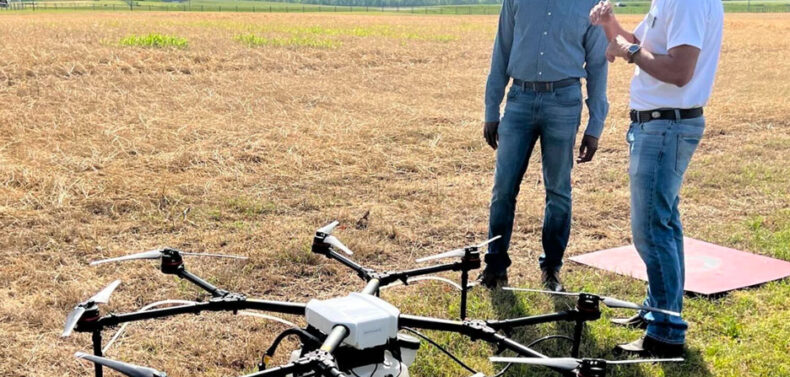U.S. Sen. Raphael Warnock took a ride on an unusual tractor earlier this month. The driver held up his arms in the classic “Look, ma, no hands!” pose, but Warnock was never in any danger.
Warnock, a member of the Senate Agriculture Committee, visited the University of Georgia’s Iron Horse Farm south of Watkinsville on Thursday for a demonstration on the latest in precision agriculture technology, including the self-driving tractor that he took for a spin.
Farmers today can increase their profits with a wide array of high-tech equipment. Satellite-connected smart devices can allow them to track data on soil conditions and intelligently place seeds, water, fertilizer and pesticides exactly where they need to be, saving resources and money. But new technology often requires troubleshooting, and Warnock said he’s aiming to fix a connectivity bug within the latest agriculture hardware. There is no standard way for these devices to share data with one another, so farmers could find themselves with a soil monitor in the ground that is unable to communicate with the tractor they need to spread fertilizer, making it less convenient and costlier to adopt the new technology.
“When I have system A inside my tractor, trying to control valves outside my tractor that are made by system B, sometimes there’s a challenge there,” said Eric Elsner, farm manager at UGA’s J. Phillip Campbell Jr. Research and Education Center. “If I get data from system A, try to use that data with system B, it’s like, if I had an Apple phone and you had an Android phone, we should be able to communicate.”
Last month, Warnock and South Dakota Republican Sen. John Thune introduced legislation to create a working group to study creating standards to ensure different devices can connect. Warnock is working to get the measure included in the 2023 Farm Bill, which Congress passes every five years to set the nation’s food and agriculture policy. The current law is set to expire in September.
“The profitability margin for farmers is so narrow that every little bit helps,” Warnock said. “And we saw today the huge difference that this technology is already bringing, but it could be much better.”
After the tech demos, Warnock sat around a table with a group of North Georgia farmers who said they’ve seen success incorporating new technology, but precision agriculture has its hurdles. In addition to connectivity issues, the equipment is a major financial investment, and some said the rural broadband required still needs work.
Fight Over Food Assistance
The main battle lines around this year’s proposed Farm Bill revolve around the Supplemental Nutrition Assistance Program (SNAP), informally known as food stamps, which makes up the largest portion of the bill.
In an exchange with Secretary of Agriculture Tom Vilsack last month, Republican congressman Austin Scott, vice chair of the House Agriculture Committee, questioned whether the proposed SNAP spending is appropriate. “The 2023 Farm Bill is currently projected to spend approximately 4% on commodity programs and 7% on crop insurance,” said Scott, who represents the Macon area. “That’s less than 12% that would actually go to support production agriculture, 82% of it goes to SNAP.”
House Republicans castigated the U.S. Department of Agriculture for allowing SNAP benefits to increase beyond inflation for the first time in 45 years in 2021, and accused it of mismanaging a plan to reevaluate food costs. They argued that the program’s work requirements should be made stricter.
“No matter how much you give somebody in SNAP benefits, if the cost of groceries continues to go up because of inflation and bad policies, then they have less food to eat at the end of the day,” Scott said. “Even if you doubled their food stamps, if the price of eggs goes up three-fold, then they can buy fewer eggs with the same number of dollars.”
As of the end of 2022, just over 1.6 million Georgians, or about 14.9%, participated in the federal food assistance program, which provides families in need with a card that can be used like a debit card to buy eligible food in grocery stores. Nationwide, the number was about 42.5 million, or 12.8%. In 2022, the average beneficiary received about $240 per month for a nationwide cost of over $119 billion.
Currently, SNAP participants who are not seniors, disabled or otherwise exempt must participate in work or job search requirements. The U.S. Government Accountability Office found that among the 9 million wage-earning adults in households receiving SNAP assistance, about 70% worked full-time hours on a weekly basis.
Two Georgia Democrats sit on the House Agriculture Committee: David Scott, the ranking member of the committee, and Sanford Bishop. Speaking to the 2023 Agri-Pulse Ag & Food Policy Summit in Washington last month, David Scott said Democrats will be united in their support for SNAP.
“We need to finally accept SNAP, and right now, the last thing we need to be talking about is trying to get people off of SNAP,” he said. “What these rather extreme Republicans want to do is to take SNAP and try to say they want to put strict working requirements. We already have working requirements.”
This article originally appeared at georgiarecorder.com.
Like what you just read? Support Flagpole by making a donation today. Every dollar you give helps fund our ongoing mission to provide Athens with quality, independent journalism.










